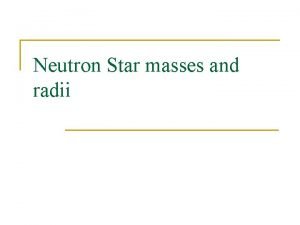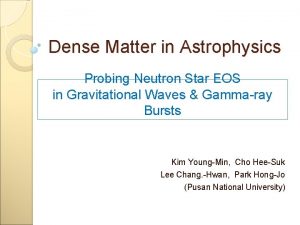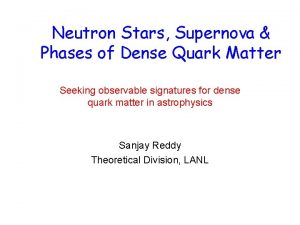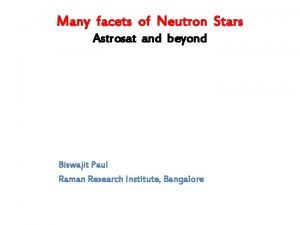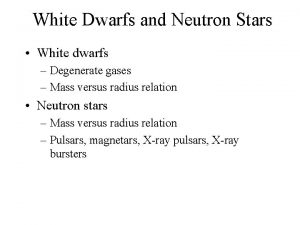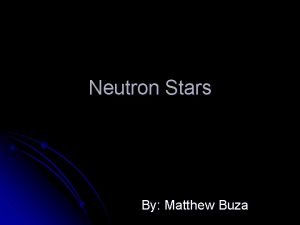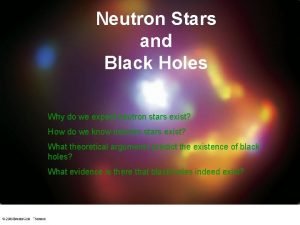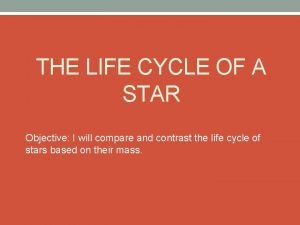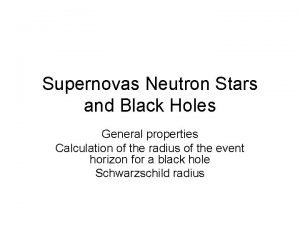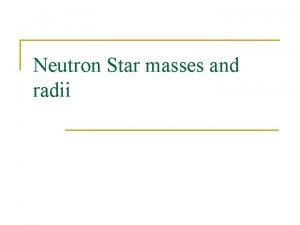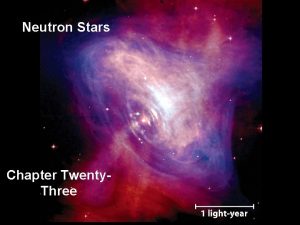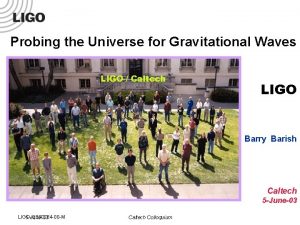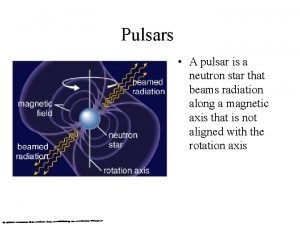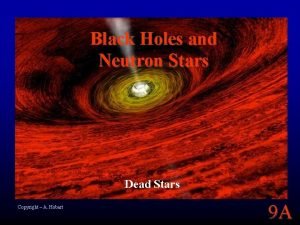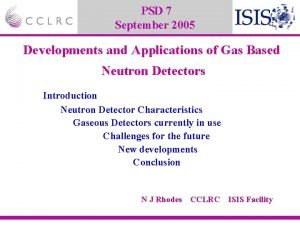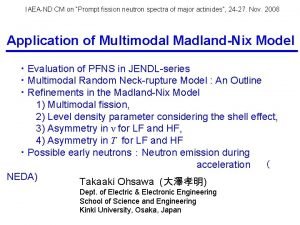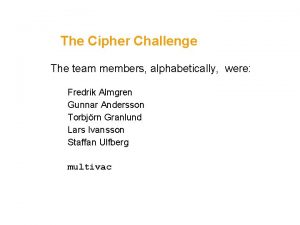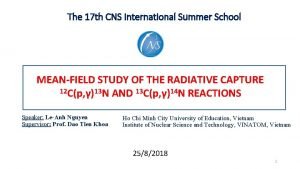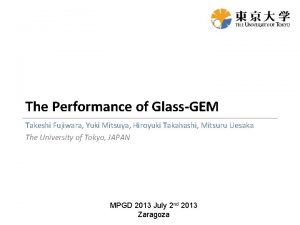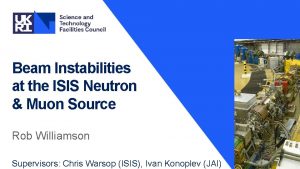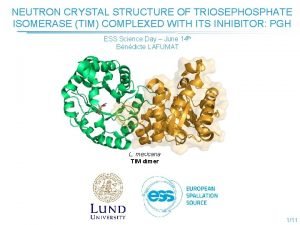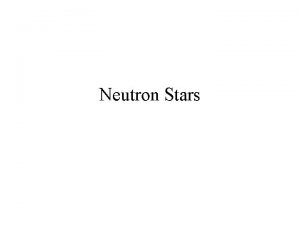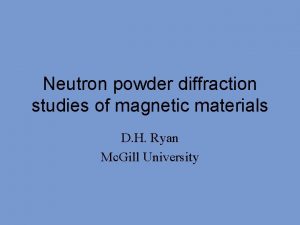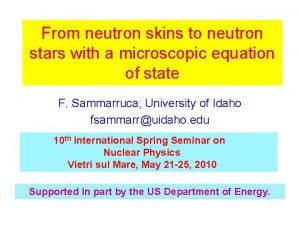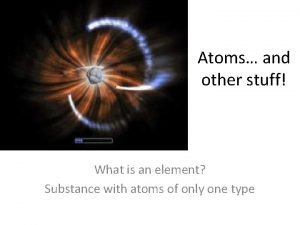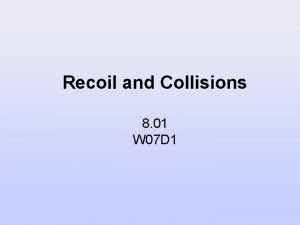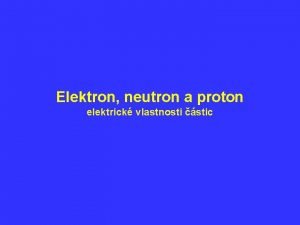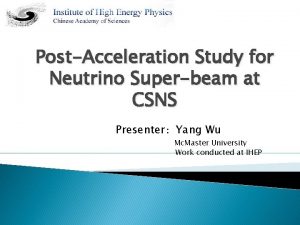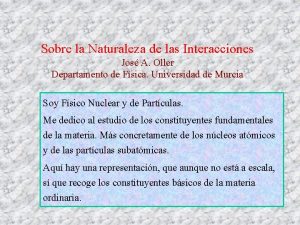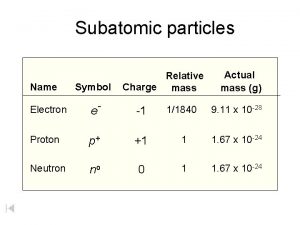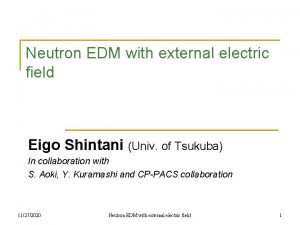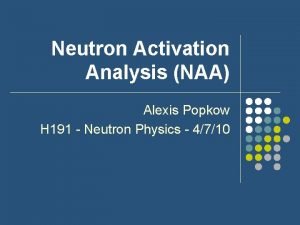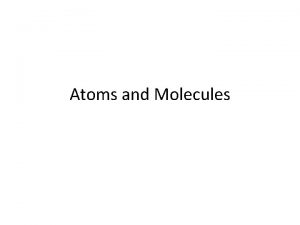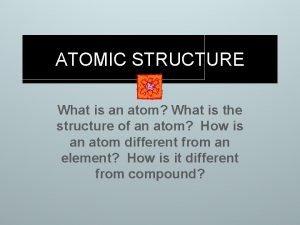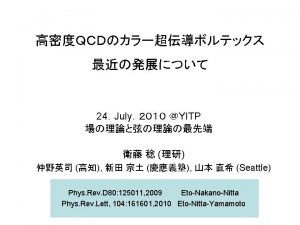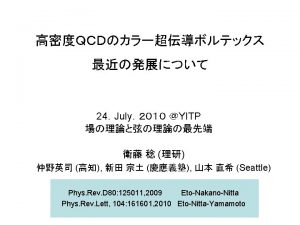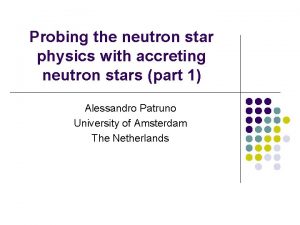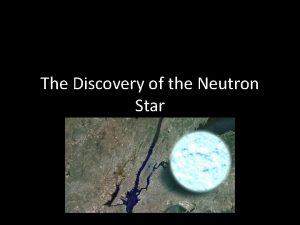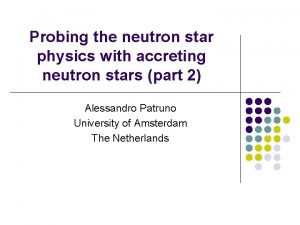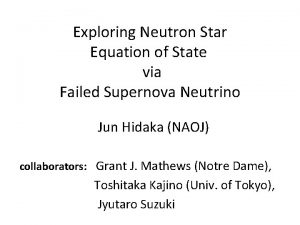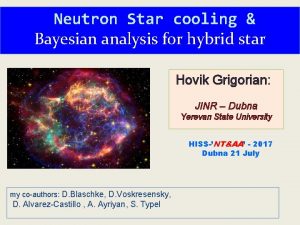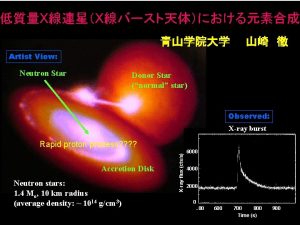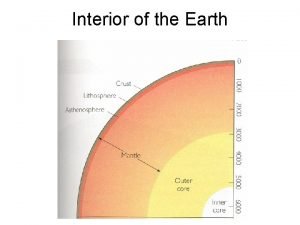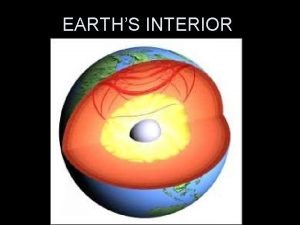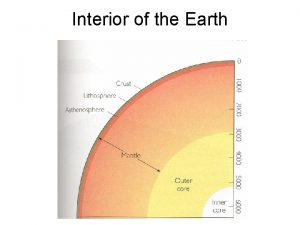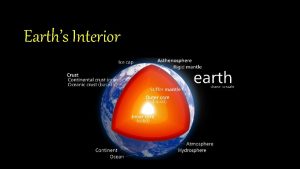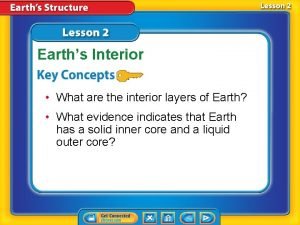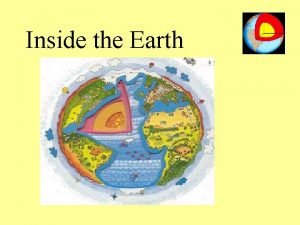Exploring interior of neutron star through neutron star




































![Lenard integral [A. Lenard (1953), Landau & Lifshitz] For other application, e. g. muon Lenard integral [A. Lenard (1953), Landau & Lifshitz] For other application, e. g. muon](https://slidetodoc.com/presentation_image_h2/71b83356233a04224975c73e01078f97/image-37.jpg)







- Slides: 44

Exploring interior of neutron star through neutron star cooling T. Tatsumi (Kyoto U. ) I. Introduction II. Thermal evolution of neutron stars -Basic concepts of cooling curve of neutron stars III. Neutrino luminosity as a probe of new form of matter inside neutron stars IV Observation of Cas A and nucleon superfluidity V Summary and concluding remarks

I. Introduction crust Structure of neutron stars core

EOS (Equation of state) gives M-R relation (Bulk properties of neutron stars) Cooling curve (Thermal evolution) (Magnetic evolution) Can microphysics understand or explain these observables ? ・There have been measured various observables about neutron stars , and great progress in observational technique. ・Unfortunately, most of phenomena occurs near the surface , and can provide us with indirect information about interiors of neutron stars, especially the core region, except their bulk properties. ・Among them neutron star cooling can give direct information of properties of matter at high densities through neutrino emission.

Magnetars (1985) Dipole radiation

R. A. Hulse and J. H. Taylor, Ap J. !95(1975) L 51. J. Antoniadis et al. Science 340 (2013) 6131 (P. B. Demorest, Nature 467, 1081, 2010) J. Lattimer, ar. Xiv: 1305. 3510

(P. B. Demorest, Nature 467, 1081, 2010)

Comparison with observation D. Page, ar. Xiv: 1206. 5011 Crab Vela Cas A 3 C 58 Cas A Young pulsars

II. Thermal evolution of neutron stars


(crust)

Cold catalyzed matter: ・chemical equilibrium ・charge neutrality Ex) n, p, e matter For free particles triangle condition: Direct URCA (b decay) cycle is strongly suppressed in normal neutron star matter. e n Modified URCA N N

Basic Cooling: neutrino vs photon cooling eras Neutrino Cooling era: Ln >> Lg Photon Cooling era: Ln << Lg

“Standard” scenario Relaxation Neutrino cooling Photon cooling No superfluid MURCA (slow cooling) 3 C 58 D. G. Yakovlev and C. J. Pethick, Ann. Rev. Astron. Astrophys. 42 (2004) 169.

III. Neutrino luminosity as a probe of new form of matter inside neutron stars Standard cooling Modified URCA+photon (+superfluidity) Fast cooling Exotic cooling for 3 C 58, Vela New form of matter Slow cooling

New form of matter or Various phases inside neutron stars Boson Hyperonic Condensate Matter Quark K ΣΛ d π u s Matter u s Strange d Quark Matter

Everywhere in neutron star cores. Most important in low-mass stars. Modified Urca process Bremsstrahlung Inner cores of massive neutron stars: Nucleons, hyperons Pion condensates Kaon condensates Quark matter

Fast cooling vs slow cooling Exotic cooling – Impact of 3 C 58 is the remnant of a supernova observed in the year 1181 by Chinese and Japanese astronomers. A long look by Chandra shows that the central pulsar - a rapidly rotating neutron star formed in the supernova event - is surrounded by a bright torus of X-ray emission. An X-ray jet erupts in both directions from the center of the torus, and extends over a distance of a few light years. Further out, an intricate web of X-ray loops can be seen. 3 C 58 (NASA, 2004)

CONCLUSIONS about the THEORY • EOS quite well determined • The mass of the star has little impact • The dominant neutrino emission process is from the formation and breaking of Cooper pairs from the neutron 3 P 2 gap (unless this gap is very small) • Possibility of the presence of light elements in the envelope allows to accommodate a range of Te at a given age h’ e n S. Tsuruta et al. , Ap. J. 571 (2002) L 143. h

IV. Observation of Cas A and nucleon superfluidity W. C. G. Ho et al, Nature 462 (2009) 71 NASA K. G. Elshamouty et al. , ar. Xi. V: 1306. 3387

D. Page, ar. Xiv: 1206. 5011 Cas A 3 C 58

Predictions for the NEUTRON 1 S 0 gap Medium polarization effect O(1/3) Important feature: WE DO NOT REALLY KNOW WHAT IT IS Medium polarization effects were expected to increase the 3 P gap while they probably 2 strongly suppress it.

Cooling of compact stars and superfluidity D. Page et al. , astro-ph/0508056 D. G. Yakovlev and C. J. Pethick, Ann. Rev. Astron. Astrophys. 42 (2004) 169. New form of matter ・Enhancement of neutrino luminosity ・Suppression by the pairing

Neutrino cooling era Photon cooling era

Neutrino emission through the formation and breaking of Cooper pairs (PBF) Cooper pair Quasi-particles c. f. Quasiparticle recombination time (life-time) in a superconductor Flowers, Ruderman & Sutherland, Ap. J. 205 (1976), 541 Voskresenskii & Senatorov, Zh. Eksp. Teor. Fiz. 90 (1986), 1505 [JETP 63 (1986), 885] Voskresenskii & Senatorov, Yad. Fiz. 45 (1987), 657 [Sov. J. Nucl. Phys. 45 (1987), 411] D. G. Yakovlev et al. , A&A 343(1999) 650. See also J. R. Schriefer and D. M. Ginsberg, PRL 8 (1962) 207.

Neutral-current weak interaction ex) Singlet pairing (Flowers, Ruderman & Sutherland, Ap. J. 205 (1976), 541) Quasi-particle op. Emissivity (singlet pairing case)

Emissivity below Tc c. f. E. Flowers et al. , Ap. J 205(1976)541.

Cooper Pair Neutrino Luminosities vs MURCA and Photons Cas A is around here? Cooper cooling

D. Page, ar. Xiv: 1206. 5011 Cas A 3 C 58

Comments about neutral current processes:

well known unknown ~ 0. 3 ~1. 47 Ratio of the reaction rate Spin content of proton, especially due to ss sea (T. T. , T. Takatsuka, R. Tamagaki, PTP 110 (2003) 179. )

V Summary and concluding remarks ・Cooling of neutron stars has provided us with information of high-density matter through the neutrino emission mechanism. ・Surface temperature of some pulsars has already suggested a fast cooling, which may need exotic cooling. ・Recent observation of Cas A may give information of nucleon superfluidity. ・Can we catch an evidence about Quark Matter through cooling of “neutron stars”? ・Simultaneous observation of surface temperature and other observables such as mass, radius … is desired to extract definite conclusions.


平均場近似とBogoliubov-Vanatin 変換


Vector current only:

![Lenard integral A Lenard 1953 Landau Lifshitz For other application e g muon Lenard integral [A. Lenard (1953), Landau & Lifshitz] For other application, e. g. muon](https://slidetodoc.com/presentation_image_h2/71b83356233a04224975c73e01078f97/image-37.jpg)
Lenard integral [A. Lenard (1953), Landau & Lifshitz] For other application, e. g. muon decay:



Neutral current D. G. Yakovlev et al. , A&A 343(1999) 650 (Non-rela. ) Fermi’s Golden rule:




II. Thermal evolution of neutron stars (I. Sagert et al. , ar. Xiv: 0809. 4225) (T. Fischer, CSQCDII)
 Star of wonder star of night star of royal beauty bright
Star of wonder star of night star of royal beauty bright Neutron star
Neutron star Neutron star
Neutron star Neutron star router
Neutron star router Neutron star
Neutron star Neutron star
Neutron star Angular momentum
Angular momentum Neutron star
Neutron star How are neutrons formed
How are neutrons formed White dwarf neutron star black hole
White dwarf neutron star black hole Schwarzschild radius
Schwarzschild radius Neutron star
Neutron star Neutron star
Neutron star Binary neutron star
Binary neutron star Neutron star
Neutron star By one man sin
By one man sin Furcation involvement classification
Furcation involvement classification Tangential sawing advantages
Tangential sawing advantages Night of the scorpion story
Night of the scorpion story Ao * algorithm
Ao * algorithm What does star in star events stand for
What does star in star events stand for Neutron degeneracy pressure
Neutron degeneracy pressure Spallation neutron source
Spallation neutron source Actinides
Actinides Cipher neutron
Cipher neutron Neutron capture
Neutron capture Neutron superhighway
Neutron superhighway Neutron dosimeter
Neutron dosimeter Isis neutron and muon source
Isis neutron and muon source Lauege
Lauege Neutron 1932
Neutron 1932 Magnets for neutron diffraction
Magnets for neutron diffraction Neutron skin
Neutron skin Hydrogen isotope with 1 neutron
Hydrogen isotope with 1 neutron Neutron labs w07
Neutron labs w07 Elektron proton neutron
Elektron proton neutron Spallation neutron source
Spallation neutron source Proton neutron quarks
Proton neutron quarks Descubrimiento del neutrón
Descubrimiento del neutrón Neutron particle symbol
Neutron particle symbol Nedm meaning
Nedm meaning Neutron activation analysis
Neutron activation analysis Atom proton neutron electron
Atom proton neutron electron How many protons are in hydrogen
How many protons are in hydrogen Mass of neutron
Mass of neutron

